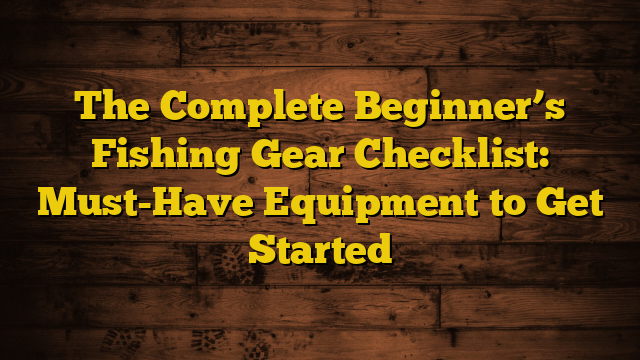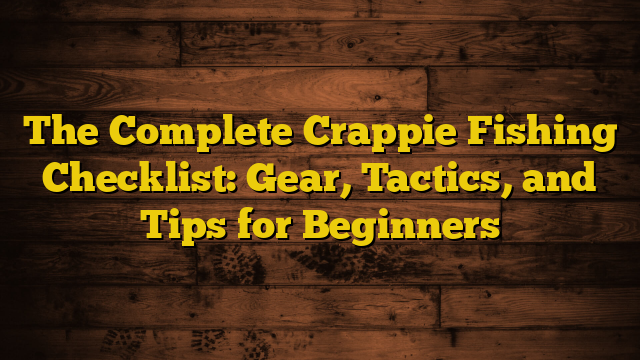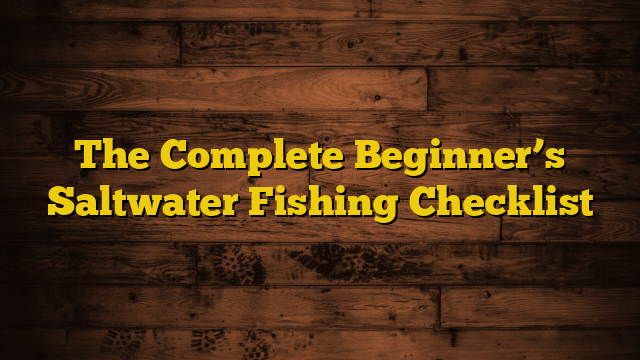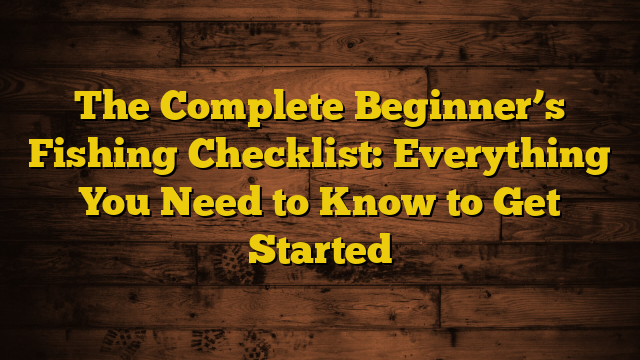Ready to try your hand at landing the “big one” but don’t know where to start gear-wise? This detailed checklist will walk through all the fishing equipment and tackle a beginner needs to head out on the water with confidence.
Whether you’re shore fishing your local pond or booking an offshore charter, having the proper basic fishing gear is crucial to success. Nothing derails a fishing trip faster than showing up ill-prepared equipment-wise.
Use this beginner’s fishing checklist to shop smart for hardgoods, tools, terminal tackle, electronics, and all the essential extras to make sure your first fishing adventure is a smooth one. With the right fishing rods, reels, lures, tools and basic skills, reeling in your catch of a lifetime is within reach!
Rod and Reel – The Fishing Foundation
The connected fishing rod and reel serve as the fundamental tool for any angler. As a beginner, you’ll want to start with a versatile and affordable rod-reel combo suitable for freshwater fishing.
For versatility, a 6-7 foot medium power, moderate action spinning or baitcasting rod paired with a compatible reel is ideal. This setup allows you to fish for everything from bluegill to bass. Look for rods with stainless steel guides and graphite or composite blanks in the $50-$75 range. Choose a reel size that can hold 200+ yards of 10-12 lb test fishing line.
Popular beginner rod and reel brand names include UglyStik, Shakespeare, Abu Garcia, Shimano, Okuma and Lew’s. Check manufacturer sizing guides to match your reel properly to the rod. Invest in quality while staying budget friendly as a newcomer.
Fishing Line – Connects You to the Fish
Fishing line is what connects your lure or bait to the reel. Monofilament line is a good all-around choice for beginners since it’s affordable, versatile, and easy to use.
You’ll want to pick a line weight or “pound test” that matches your rod and reel combo. 10-12 lb test works well for most medium power setups. If you go too light, the line can break when you’re setting the hook or fighting fish. Too heavy, and casting and reeling suffers.
It’s good to have line in clear, green, red, yellow for different water conditions. Always check your line for frays and change it frequently. Keep extra spools of line in your tackle box.
Terminal Tackle – Linking Lures to Lines
Terminal tackle comprises the hooks, swivels, weights, and leaders that connect your lure or bait to the fishing line. Beginners need:
- Hooks – Single, treble, and double hooks in a range of sizes to match baits and lures.
- Fishing bobbers – Plastic floats that suspend live bait at a fixed depth.
- Sinkers – Add casting weight and sinks bait into strike zones.
- Swivels – Used to prevent line twist when attaching lures or leaders.
- Snap, barrel and ball bearing swivels are common types.
- Leaders – Attaches between main line and lures to prevent bite-offs.
Lures – Artificial Bait to Catch Fish
Every angler needs a tackle box stocked with a variety of lures like:
- Crankbaits – Artificial minnow baits that dive and wiggle
- Spinners and spoons – Metal lures with spinning actions
- Soft plastic baits – Worms, crawfish, slugs and more
- Topwater lures – Imitate injured or surface prey
- Jigs – Lead head lures adorned with hair, plastic or rubber
Try different styles, colors, and sizes of lures to determine what triggers fish strikes. Hard and soft varieties all catch fish.
Live Bait – Natural Offerings for Picky Eaters
While artificial lures work extremely well, live bait like worms, minnows, crayfish, and shrimp tempt even the pickiest fish. Purchase bait each trip from local shops or collect it yourself. Keep alive in an aerated bucket or cooler. Favorites like nightcrawlers can be homegrown.
Tip: Catch a few small sunfish or crappie and use them as irresistible live bait!
Fishing Tools – Handy Helpers for Efficient Angling
Specialized fishing tools make time on the water more convenient and productive:
- Fishing pliers – Unhooks fish safely and extracts swallowed hooks
- Knives – Cut lines, rig live bait, prep catches for eating
- Tackle boxes – Organize a tangle of terminal tackle in one box
- Cooler – Keeps your catch fresh and cold on ice
- Tape measure – Check legal fish sizes and track personal bests
- Stringer – Keep catches alive on a rope in the water
- Camera – Capture memories of trophy catches
- Waders or boots – For walking and wading into lakes and rivers
- Polarized sunglasses – Cuts glare to spot fish and structure underwater
- Fish gripper – Control feisty fish while unhooking
- Multi-tool – Makes quick fishing gear repairs
- Headlamp – Allows early morning and night fishing
- Hip/waist pack – Carry tackle, tools and sun protection hands-free
Must-Have Extras and Safety Equipment
Round out your beginner fishing setup with these additional accessories and safety essentials:
- Fishing license – Required in most states for anglers over 16
- Life jacket – Critical for safety around water
- Sunscreen and hat – Prevent painful sunburn
- Bug spray – Repels mosquitos and biting insects
- First aid kit – Treats minor cuts, abrasions
- Retractors – Prevent losing rods overboard
- Line clippers – Cut line cleanly without fraying
- Fishing gloves – Protect hands from hooks and hot reels
- Wading staff – Provides stability for river wading
- Whistle and phone – Emergency communication
- Flares and lights – For night time visibility
- Firearm – Protect yourself in bear country
Ready, Set, Fish!
With quality rods, reels, tackle, tools and accessories in hand per this checklist, beginners can head out on local waters with confidence. Focus on acquiring essential gear as you hone skills through hands-on experience.
Soon enough you’ll be landing bucketmouth bass, fighting freight train catfish, and hauling in lunker trout like a seasoned angler thanks to this complete beginner’s fishing gear checklist.







